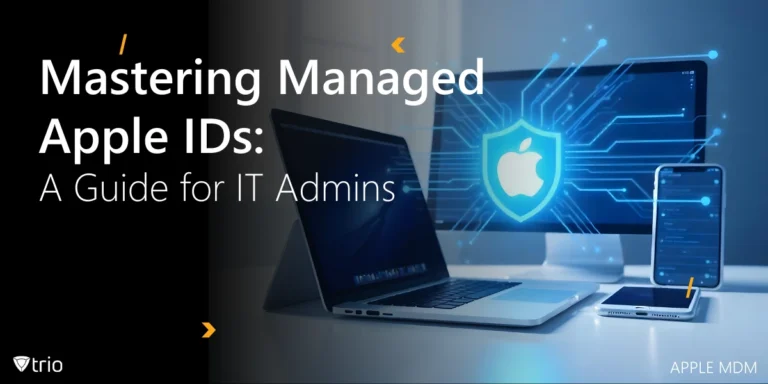Every day, we interact with numerous applications, often across different operating systems. Our phones may run on Android, while our laptops may operate on ChromeOS or Windows. Behind each of these applications, there are major companies working tirelessly to enhance the user experience, offer new features, and address any bugs or vulnerabilities. The task of managing updates on our personal devices alone can be challenging. Now, imagine the difficulties faced by IT administrators in large companies who ensure the security and up-to-date status of every device within their network. It’s an intricate task that requires careful attention and diligence.
Modern problems require modern solutions. Patch management refers to the process of regularly updating and applying patches, or fixes, to software systems or applications in order to address security vulnerabilities and enhance overall system performance. This process is critical to IT security, as it helps organizations stay ahead of cyber threats and protect sensitive data. However, many organizations still overlook the importance of patch management, putting themselves at significant risk. This article will explore the risks of ignoring patch management and provide best practices for staying ahead of the game.
The Risks of Ignoring Patch Management
Security vulnerabilities in outdated software
The constant need for evolution and improvement is ingrained in our nature, and this principle applies to our digital lives as well. In the realm of digital evolution, there are two interconnected aspects: as software is utilized and evolves over time, new security threats and attack techniques also emerge. Developers continuously release updates and patches to address these vulnerabilities and improve the security of their software. However, if users neglect to install these updates, their systems remain susceptible to exploitation, as known vulnerabilities persist. Hence, it becomes imperative to prioritize patch management for device security.

Increased risk of cyber attacks
As the vulnerabilities persist, they serve as entry points for cybercriminals to gain unauthorized access, execute malicious code, or steal sensitive data. Not having proper patch management leaves the door open for attackers who are actively looking for systems that have not implemented the latest patches. They search for specific vulnerabilities that have well-known fixes. By specifically targeting these vulnerabilities, they launch attacks such as injecting malware, conducting phishing campaigns, or taking control of compromised systems.
Compliance issues
In an enterprise, compliance refers to the act of adhering to all applicable laws and regulations. This includes both internal policies and procedures, as well as external requirements imposed by government agencies, industry organizations, and stakeholders. This regulatory procedure requires mundane everyday patching and updates. For instance, the Payment Card Industry Data Security Standard (PCI DSS) requires organizations that handle credit card information to regularly apply security patches within a specific timeframe. Consequently, failure to comply with these regulations may result in financial penalties, legal consequences, and damage to the organization’s reputation.
Financial costs of a security breach
A data breach’s financial costs can be crippling for an enterprise. Apart from direct costs like incident response and legal fees, the company has to deal with reputational damage, decreased customer retention rates, and the need to restore system infrastructure. According to IBM’s 2023 report on the cost of a data breach, the global average has reached an all-time high of $4.45 million. This figure demonstrates a 2.3% increase compared to the previous year and a significant 15.3% rise from 2020.
Staying Ahead of the Game: Best Practices for Patch Management
Automating patch management processes
The diversity of apps, software, operating systems, and regulations your company has to keep up with creates the demand for a management solution that can automatically and rapidly discover and deploy these patches. This enhances efficiency, avoids human error, and creates a compliant organization, allowing IT admins to save valuable time and focus on other tasks. Patch management automation allows for consistency across all devices and platforms.

Establishing a patch management policy
Establishing a comprehensive patch management policy is crucial for any enterprise. The policy sets objectives for maintaining a secure environment by assigning clear roles and responsibilities. It also defines the scope by identifying all systems and applications and specifying the extent to which it applies to them. This includes determining whether the policy is applicable to all devices, such as employee workstations, servers, networking devices, and third-party applications.
Conducting regular vulnerability assessments
The vulnerability assessment process, as the name suggests, involves constant scanning of devices and networks for potential weaknesses and vulnerabilities. After weaknesses are scanned and identified, patch management uses this information to prioritize the patching process based on the level of risk involved. Together, these two procedures complement each other by creating a flow of constant improvement in your system. This way, potential risks are addressed the very moment they arise, keeping you always ahead of threats.
Prioritizing critical patches
Not all patches require immediate attention. The severity of the patch plays a significant role in this equation by determining the potential impact of the unaddressed weaknesses. As mentioned previously, the patch management solution adopts a risk-based approach to prioritize patches with the highest vulnerability and exploitability. Moreover, patches that are more relevant to your environment are also prioritized by patch management.
Tools and Resources for Effective Patch Management
Overview of popular patch management tools and Open-source alternatives
Many patch management solutions in the market strive to offer the best solutions to all enterprises. Some of these popular patch management solutions include Microsoft WSUS (Windows Server Update Services), IBM BigFix, and SolarWinds Patch Manager. These software patch management options offer comprehensive features, including automated patch deployment, vulnerability scanning, and reporting. Also, open-source patch management tools such as Opsi, WPKG, and Gosa can be viable alternatives for organizations on a limited budget. These tools offer flexibility and customization options without sacrificing functionality.
What Makes Trio the Most Comprehensive Option?
Trio is an MDM solution that offers powerful and user-friendly features to businesses, including patch management. Trio offers a centralized platform and cloud-based patch management that empowers IT administrators to efficiently manage and deploy patches across all endpoints to simplify and strengthen the patching process. Now, it’s time to say farewell to the hassle of manual patch deployment. With Trio, IT admins can schedule patches to be downloaded and deployed at specific times, reducing operational costs and ensuring timely patching.
Trio empowers organizations to monitor patch compliance to make sure all devices are up to date. It also employs algorithms to prioritize patches based on severity, system criticality, and potential impact. This helps organizations focus on critical patches that address the most significant vulnerabilities, reducing risks effectively. The trio is compatible with multiple software vendors and systems, making it adaptable to diverse IT environments. It provides seamless integration with popular vendors and ensures comprehensive patch coverage across the organization’s software and hardware infrastructure.
Trio allows organizations to enhance their patching process, improve overall security, and minimize the risks associated with unpatched system and software vulnerabilities. Trio’s automated patch management simplifies the complex task of manual patch management. It allows IT admins to focus on strategic initiatives and ensure their systems are protected from emerging threats.
Conclusion
The risks of ignoring patch management are significant and can lead to severe consequences for businesses. Organizations can enhance their security and avoid catastrophic outcomes by prioritizing patch management, automating patching deployment, establishing clear policies, and conducting regular vulnerability assessments. Businesses that overlook the importance of it are constantly wrestling with potential data breaches and compliance issues. This problem not only results in financial costs for them but also costs them their invaluable reputation
.
Patch management is a crucial tool for IT admins to ensure the security of their organization’s system infrastructure. By utilizing software patch management, IT professionals can effortlessly keep all software up to date. Consequently, this improves system stability and performance, reduces downtime, and increases overall productivity. Let’s remember to point out that automated patch management can save time and costs for IT admins and reduce their workload. Giving them more time to focus on more strategic tasks. More importantly, effective patch management software helps them mitigate risks before they become significant issues. Ultimately protecting an organization’s valuable digital assets, sensitive data, intellectual property, and customer information.
See Trio in Action: Get Your Free Trial Now!
Remember, effective patch management is a continuous effort that requires ongoing dedication and investment. Trio is here to make this process a breeze and keep you always ahead. By embracing Trio’s proactive approach, organizations can bolster their security defenses and protect themselves against potential vulnerabilities. The trio is here to make your business fully invincible.




